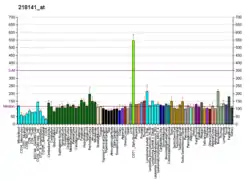UBE2O
Ubiquitin-conjugating enzyme E2 O is a protein that in humans is encoded by the UBE2O gene.[5][6][7]
UBE2O functions during terminal erythroid differentiation to eliminate generic cellular components in parallel with abundant synthesis of hemoglobin.[8]
References
- GRCh38: Ensembl release 89: ENSG00000175931 - Ensembl, May 2017
- GRCm38: Ensembl release 89: ENSMUSG00000020802 - Ensembl, May 2017
- "Human PubMed Reference:". National Center for Biotechnology Information, U.S. National Library of Medicine.
- "Mouse PubMed Reference:". National Center for Biotechnology Information, U.S. National Library of Medicine.
- Yokota T, Nagai H, Harada H, Mine N, Terada Y, Fujiwara H, Yabe A, Miyazaki K, Emi M (Apr 2001). "Identification, tissue expression, and chromosomal position of a novel gene encoding human ubiquitin-conjugating enzyme E2-230k". Gene. 267 (1): 95–100. doi:10.1016/S0378-1119(01)00407-3. PMID 11311559.
- Nagase T, Kikuno R, Hattori A, Kondo Y, Okumura K, Ohara O (Feb 2001). "Prediction of the coding sequences of unidentified human genes. XIX. The complete sequences of 100 new cDNA clones from brain which code for large proteins in vitro". DNA Res. 7 (6): 347–55. doi:10.1093/dnares/7.6.347. PMID 11214970.
- "Entrez Gene: UBE2O ubiquitin-conjugating enzyme E2O".
- Nguyen AT, Prado MA, et al. (2017). "UBE2O remodels the proteome during terminal erythroid differentiation". Science. 357 (6350): eaan0218. doi:10.1126/science.aan0218. PMC 5812729. PMID 28774900.
Further reading
- Maruyama K, Sugano S (1994). "Oligo-capping: a simple method to replace the cap structure of eukaryotic mRNAs with oligoribonucleotides". Gene. 138 (1–2): 171–4. doi:10.1016/0378-1119(94)90802-8. PMID 8125298.
- Suzuki Y, Yoshitomo-Nakagawa K, Maruyama K, et al. (1997). "Construction and characterization of a full length-enriched and a 5'-end-enriched cDNA library". Gene. 200 (1–2): 149–56. doi:10.1016/S0378-1119(97)00411-3. PMID 9373149.
- Strausberg RL, Feingold EA, Grouse LH, et al. (2003). "Generation and initial analysis of more than 15,000 full-length human and mouse cDNA sequences". Proc. Natl. Acad. Sci. U.S.A. 99 (26): 16899–903. doi:10.1073/pnas.242603899. PMC 139241. PMID 12477932.
- Tomsig JL, Snyder SL, Creutz CE (2003). "Identification of targets for calcium signaling through the copine family of proteins. Characterization of a coiled-coil copine-binding motif". J. Biol. Chem. 278 (12): 10048–54. doi:10.1074/jbc.M212632200. PMID 12522145.
- Ota T, Suzuki Y, Nishikawa T, et al. (2004). "Complete sequencing and characterization of 21,243 full-length human cDNAs". Nat. Genet. 36 (1): 40–5. doi:10.1038/ng1285. PMID 14702039.
- Gerhard DS, Wagner L, Feingold EA, et al. (2004). "The status, quality, and expansion of the NIH full-length cDNA project: the Mammalian Gene Collection (MGC)". Genome Res. 14 (10B): 2121–7. doi:10.1101/gr.2596504. PMC 528928. PMID 15489334.
- Pope SN, Lee IR (2005). "Yeast two-hybrid identification of prostatic proteins interacting with human sex hormone-binding globulin". J. Steroid Biochem. Mol. Biol. 94 (1–3): 203–8. doi:10.1016/j.jsbmb.2005.01.007. PMID 15862967. S2CID 9746088.
This article is issued from Wikipedia. The text is licensed under Creative Commons - Attribution - Sharealike. Additional terms may apply for the media files.





